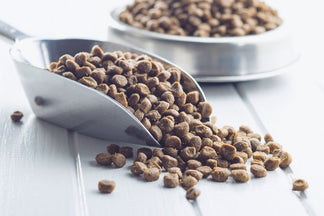As discussed in our posts on protein, both dogs and cats require diets that are high in animal proteins. Many pet owners don’t realize that their pets are also well suited to diets that are moderately high in fat as well.
Why Fat?
Fat is an important macronutrient for both dogs and cats. Dietary fat provides a myriad of benefits including:
- Fat is a dense source of energy (calories) that is necessary to keep your pet active.
- Fat provides essential nutrients such as omega-3 and omega-6 fatty acids, which are vital to keeping your pet’s skin and coat healthy. Restricting fat or providing low quality fat sources can often lead to a coarse, dull coat and dry, itchy skin, among other things.
- Fat is important for reproductive efficiency, kidney function and the absorption of the fat soluble vitamins, A, D, E, and K.
- Fat helps with overall immune regulation, which helps your pet fight off disease and infections.
- Fat serves as a metabolic source of water, reducing the likelihood of dehydration. Perhaps this is a reason to slightly increase the fat content in your dog’s diet during the summer months?
- Fat is highly palatable.
How Much Fat?
The Association of American Feed Control Officials (AAFCO) publishes nutritional minimums and standards for pet foods based on the life stage of the pet. The tables below shows the AAFCO protein and fat minimums for dogs and cats respectively.
How Much Fat is Too Much?
Despite all of the benefits of fat, you should not go overboard when planning your pet’s diet. Like anything else, moderation and proper portioning is key.
Fat is the most calorie dense macronutrient- it contains 2.25 times the calories per unit as protein and carbohydrates. Thus, high fat diets are also high calorie diets and if not monitored, can lead to overweight and even obese pets. This suggests that a lower fat (not no fat!) diet can be a prudent strategy when kick-starting a pet weight loss program. Check with your vet or pet nutritionist before making any dramatic changes in your pet’s diet. As your pet ages and becomes less active, their energy requirements will lessen and thus, the amount of calories in their diet should also lessen. The best way to accomplish this is by reducing their portion, not by switching to a high carb “senior” diet, which is typically lower in protein and fat! Again, check with your vet or pet nutritionist before making any dramatic changes in your pet’s diet.Next week, we will discuss the common sources of fat in commercial pet food.
Reference:
http://www.fda.gov/animalveterinary/resourcesforyou/ucm047120.htm



 Food
Food
 Food
Food
 Food
Food
